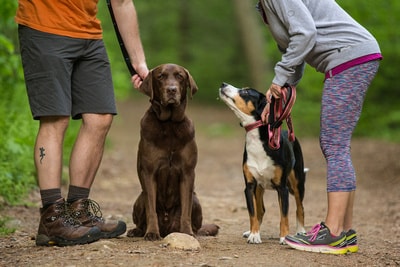
Why and How Positive Dog Training Works
Posted by Shoshi Parks on 18th December 2017

There are many different tips and tricks when it comes to dog training — but did you know there are just two major training philosophies? All dog trainers follow one or the other of these two approaches, regardless of their specific techniques. The first is called positive-reinforcement training (sometimes known as rewards-based training) and the other is traditional training.
Positive-reinforcement training is now widely embraced and considered more effective by the canine research community. However, there are many misconceptions about positive-reinforcement training. Some believe it’s just "treat training," for example. Learn more about how it works, and why positive-reinforcement training isn’t the same thing as bribery.
About Traditional Dog Training
In general, traditional dog trainers base their work on the philosophy of dominance. You'll hear them saying things like: “Be the alpha.” “Be the pack leader.” “Show your dog who’s boss.”
In this type of training, intimidation, fear, and even pain are the primary tools employed to get a dog to behave. This approach can be dangerous, because it can result in a dog that fears people or a dog that completely shuts down. In particular, equipment that causes pain, such as prong collars or shock collars, frequently backfires. Research does not support this methodology, nor do any of the professional dog training associations.
How Positive-Reinforcement Dog Training Works
Positive-reinforcement training is based on science about how dogs learn new information:
- by association (classical conditioning)
- by consequence (operant condition)
Research shows that a dog learns more quickly and effectively when rewarded for good behaviors, not punished for bad ones.
The basis of this training is straightforward. The more a dog is rewarded for a certain behavior, the more frequently that dog will practice that action, as long as the reward was sufficiently motivational.
If the dog performs an undesirable behavior, the concept of rewards still applies. How? An undesirable action occurs when a dog tries to reward himself with something. Perhaps he seeks attention or food from the table, perhaps he wants to go faster on a walk, or perhaps he wants to run to say hello to a friend when off-leash instead of coming when you call. To change the behavior, we withhold the reward until the dog offers a more desirable behavior.
Teaching vs. Bribery
There's a fine line between using rewards to teach a dog and using rewards to bribe a dog. Dogs who will only sit if there’s a treat haven't fully internalized their learning.
What’s the difference? In the first, the dog is actually learning a new behavior; in the second, the dog is simply doing what he can to acquire the reward. You can avoid bribery by following these steps.
Use science to your advantage!
- Food is not the only way to reward your dog. A reward is anything that a dog enjoys, and can include affection, toys, going for a walk, and so on.
- Your reward should only appear after your dog has completed an action. If the reward appears before your dog has completed the behavior, they have no reason to complete the action.
- If you're working on something challenging, a “high-value” reward will be more effective. Typically this means human-grade food that your dog rarely gets.
- Once your dog is catching on, begin to randomize your reward. If your dog is rewarded with a treat often, but not every time, they will continue to practice the behavior because they never know when they'll hit the jackpot.
Even after your dog is an expert at a certain behavior, never forget the power of praise and the occasional additional reward.
Rover.com connects pet parents with the nation's largest network of loving and trustworthy pet sitters and dog walkers. Through Rover, pet parents can discover, book, and manage personalized care for their dogs, including pet sitting, dog walking, in-home dog boarding, and doggy day care.
Recent posts
Ambassador Highlight: Bordercolliedraco
Draco the Border Collie loves exploring with his dog mom Kristina in Florida. We caught up with these Kurgo Ambassadors and asked them their favorite tips, tricks, and places they'd like to go.
Ask a Vet: Is Alternative Medicine Safe?
We asked veterinarian Dr. Susan O'Dell, "What are your thoughts on small animal vaccinations? Can you over vaccinate?" Read her response below! Vaccinations are an important topic to address for every pet that I see. The diseases for which we vaccinate can cause severe sickness or death in cats and dogs (rabies is also fatal [...]
How Dogs Know to Comfort us
It often seems that our dogs can sense our moods. Have you ever felt upset, and then looked down to find that your dog has run over to you? Recent research has delved into the nature of this bond. Are dogs responding to our feelings, our body language, or something else? Read on to find [...]


